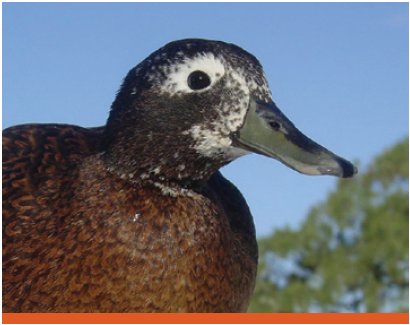Laysan Duck
The Laysan Duck, although from the first view an ordinary bird, is a great story of conservation, how a species extremely close to extinction have recovered to a relatively stable population count. Their natural habitat being only the Hawaiian Islands (just like a number of other animals, for instance Hawaiian Monk Seal), these ducks have shown that no species can be in a state of no recovery, therefore are a formidable example how with the help of humans, extinction can be prevented.
The Laysan Duck is relatively small in size, dark feathers and orange legs. It can be recognized by their white eye-rings. Male ducks have dark green bills, while the females’ are dark brown or gray. Both the sexes have a fairly similar appearance and a non-specialist wouldn’t be able to tell them apart. They’re very long-lived, aging up to 50 years.
Laysan Ducks are capable of flying, and they can actually do it quite well, but they rarely fly more than a few metres, and they do not show seasonal movements. Using their wings so sparingly, the Laysan Ducks spend most of their time in water or on land, looking for food. They mostly feed on aquatic plants, snails and seeds, although unlike many other ducks, the Laysan Ducks don’t dive, they merely plunge their head in the water. They have been observed to show interesting behavior time to time – they sprint through swarms of flies or insects with their bills open, in order to trap the flies in their mouths.
These birds start copulating in late fall and winter, afterwards building a nest in a well concealed location. Usually four eggs are lain in the nests and the ducklings started feeding on their own on day two after hatching, however are guarded by their parents for forty to sixty days. The survival of the hatchlings is largely dependent on the food available in the surroundings of the nest.
The Laysan Ducks are classified as “Critically Endangered” be the IUCN. Their population is estimated at about 600. Although this number may seem tiny, there’s been a great increase over the last 100 years. The Laysan Ducks population was severely harmed when other grass-eaters and predators were brought to the islands. Rats, pigs and mongooses all began hunting these ducks, and rabbits ate most of the island’s vegetation. The Laysan Ducks almost became extinct, when in 1909 their population reached an all-time lowest of 7 mature specimen and 5 ducklings.
Law enforcements were introduced in order to conserve these species and the rabbits on the island were exterminated, at the same time Laysan Ducks were bred in zoos, to increase their population. These strategies proved successful, bringing the population of the ducks back to a size capable of living on it’s own. The future of this birds seems optimistic and though threats still remain, their numbers are increasing and this story of success is a great example for the future.





Beautiful! Ducks are so cool. And it’s nice to read that things are starting to look better for this species’ preservation. Wildlife news regarding endangered species are usually so depressing… :(
Indeed, the story of the Laysan Duck is an example. I hope we’ll hear more of things like these happening.